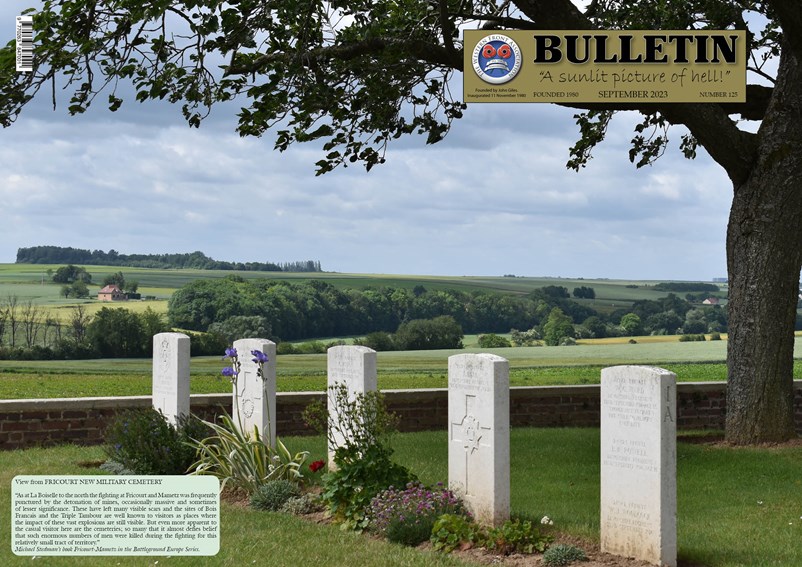Out Now. Bulletin 125. September 2023
- Home
- Latest News
- 2023
- October 2023
- Out Now. Bulletin 125. September 2023

The front and rear cover of our September issues of Bulletin shows a 'Sunlit Picture of Hell' introduced by Clive Harris of Battle Honour Tours with a photograph by Martin Barry The ground from Fricourt New Military Cemetery looking south towards the Bois Francais has changed little over the last century, except for the sprawling aircraft factory that now reaches out from Meaulte, itself a critical forward supply village in the summer of 1916. Yet the peaceful scene today hides the scars both physically on the landscape and mentally on those who knew this place, specifically on the opening day of the Somme battle.
Across this ground the men of the 10/West Yorkshires swept before encountering the newly created Triple Tambour mine craters just to the left of the picture. Here they were to endure the heaviest casualties of a single battalion throughout the whole of the war, suffering 22 officers and 688 other ranks, many of those who were killed being buried in the cemetery that today sits just short of the German front line and Tambour positions. The battalion war diary for the day records,
At 7.30 am The Battalion took part in the grand assault. On the right were the 7th Division and on the left the 21st Division. The Battalion assaulted in four lines. Two lines got through the German Position to the fourth lines and were cut off, the attack on our left having failed. Casualties were very heavy. Chiefly caused by Machine Guns which enfiladed our left flanks and were so deadly that the third and fourth lines failed to get across no-man’s land. 22 Officer casualties including Commanding Officer and Major J Knott 2nd in command (both Killed) and approximately 750 ORs. The Battalion was then withdrawn to VILLE.
Major James Leadbetter Knott, originally buried in the cemetery was later moved to Ypres Reservoir Cemetery where he is buried alongside his brother, Captain Henry Basil Knott of the Northumberland Fusiliers who had fell in September 1915, he was likely to have originally been buried in Lijssenthoek CWGC before both brothers were united in death. This unusual event was most likely due to the influence of their father, Sir James Knott who funded the tower of St George’s Chapel in Ypres in memory of his two sons, both of whom went to Eton.
One eyewitness to the fateful attack across this ground on the 1 July was Siegfried Sassoon, then serving in the support trenches at Bois Francais and overlooking the area in front of Fricourt, he describes his ‘Opera box’ view in ‘Memoirs of an Infantry officer’.
0745 – The barrage is now working to the right of Fricourt and beyond. I can see the 21st Division advancing about three-quarters of a mile away on the left and a few Germans coming to meet them, apparently surrendering.Some Yorkshires a little way below on the left, watching the show and cheering as if at a football match...I am staring at a sunlit picture of Hell.
Such scenes today seem unthinkable from the neat borders and edges of the cemetery wall overlooking the serene Picardy landscape, yet the rows of headstones remain.





